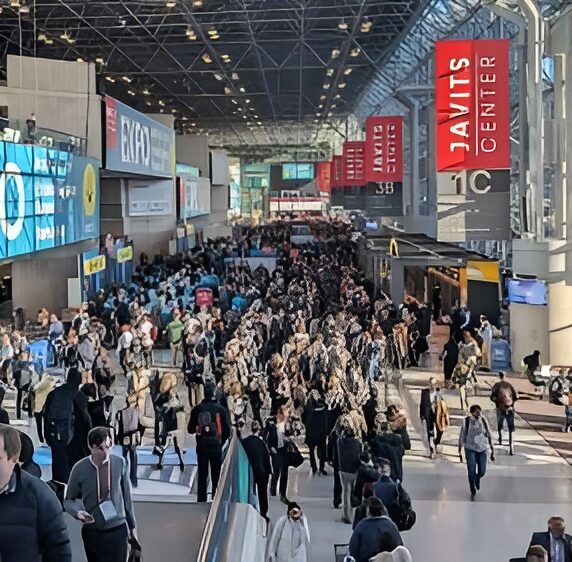Key Insights from NRF 2024: Navigating the Future of Retail
The curtains have closed on the National Retail Federation (NRF) 2024 Retail’s Big Show, and this year’s event has been extraordinary, with a record-breaking attendance of nearly 40,000 participants from around the globe. Surpassing the pre-pandemic levels of January 2020, NRF 2024 showcased a robust exchange of ideas, strategies, and insights that promise to shape the retail landscape in the coming year.
Let’s delve into our three key takeaways, recognizing the profound impact of the retail industry on everyone, everywhere, every day.
1. Artificial Intelligence – Beyond Hype to Tangible Impact
Last year’s focus on the resurgence of physical retail, and the integration of artificial intelligence (AI) took center stage once again at NRF 2024. However, this time, the spotlight shifted from the promise of these innovations to their real-world applications on the sales floor. The overarching theme was the translation of technological advancements into actionable results.
AI’s influence continues to grow, and consumers are now demanding sustainable actions. The emphasis is on leveraging AI capabilities where they can genuinely benefit businesses, prompting more educated inquiries about AI algorithms and their practical advantages. However, the industry is not immune to the risk of oversaturation, as highlighted by Marc J Metrick, CEO of Saks Fifth Avenue, who humorously noted that his Corporate communications team makes him mention AI in every investor presentation.
Industry leaders such as Walmart’s U.S. President and CEO John Furner, Ulta Beauty CEO Dave Kimbell, and Salesforce Chair and CEO Marc Benioff shared strategies focused on AI-driven technologies to enhance operational efficiency and elevate customer experiences. Amidst the AI dominance, retailers are venturing into a new era of technological innovation centered around AI and machine learning (ML), emphasizing the role of these tools as the most efficient means for retailers to extract value from data.
In the realm of adopting new solutions, a critical focus is placed on selecting tools that resonate with users. The aim is to choose solutions that are genuinely appreciated, intuitive, and easy to navigate, ultimately fostering a higher adoption rate within the company. As an example, the current excitement around Generative AI is palpable, with its potential use cases continually expanding. However, the jury is still out on evaluating the trustworthiness and practical applicability of these innovative solutions.
Another notable aspect is the ongoing journey for organizations in navigating the learning curve associated with utilizing ChatGPT, often referred to as co-pilots, in their operations. Effectively incorporating these tools necessitates a shift in thinking when seeking information. This unique approach requires users to adapt and learn the intricacies of interaction for optimal effectiveness and impactful outcomes.
In short, the dynamic landscape of AI in retail is not merely about hype but about real-world applications, sustainable actions, and strategic adoptions. As the industry continues to evolve, the intersection of AI, user-centric tools, and transformative learning approaches is poised to redefine the retail narrative, unlocking new realms of efficiency and customer-centric innovation.
2. Overcoming Challenges of Shrink and Inflation, to Prioritizing Customer Experiences
Building upon the challenges encountered in 2023, NRF 2024 took a decisive stance on critical issues, notably addressing the persistent challenges of retail shrink and inflation.
Retail shrink, an enduring issue within the industry, garnered a collective effort to surmount its detrimental effects. Last year witnessed a considerable impact on retailers’ profits attributed to shrink, commonly recognized as lost inventory. The imperative of implementing a comprehensive process to ensure full visibility into inventory has become more paramount than ever before.
Inflation, another hurdle on the retail landscape, prompted a shift in focus towards long-term business growth. NRF Chief Economist Jack Kleinhenz highlighted the remarkable resilience of consumer spending throughout 2023, culminating in a robust pace for the holiday season. While inflation posed a significant concern for households, the easing of prices for goods, coupled with a robust labor market, underscored a successful holiday season for retailers. Consumer expectations anticipate a gradual decrease in rapid inflation rates in the upcoming months and years. However, an interesting shift is observed as consumers scale back their spending plans, signaling a potential inclination to rebuild their savings. This presents a mixed set of signals for merchants, necessitating innovative and personalized approaches to encourage consumers to spend.
The spotlight this year at NRF 2024 pivoted towards prioritizing high-quality customer experiences and streamlining operations. Organizations are actively incorporating unified commerce into their core business models, strategically leveraging data analytics to understand customer behavior and offer personalized shopping experiences. Another significant challenge lies in embracing innovation and harnessing the power of data-driven personalization and AI to elevate the customer experience. This includes delivering hyper-personalized services while safeguarding customer privacy, protecting data, and providing real-time tailored offerings.
Retailers are navigating a new technological innovation phase centered around AI and ML. Recognizing AI as the most efficient means to extract value from data, retailers strategically leverage these technologies to foster growth and gain a competitive advantage across the business landscape. This transformative shift underlines the industry’s commitment to staying at the forefront of technological advancements, ensuring a dynamic and responsive approach to the evolving retail landscape.
3. Smarter Supply Chains for a Seamless E-commerce Experience, with Resilience in Midst of Uncertainty.
FedEx CEO and President Raj Subramaniam emphasized the critical importance of meeting consumer expectations anytime, anywhere, as the landscape of online retail sales is projected to reach an astounding $8 trillion annually by 2026. In a bid to secure a foothold in this expansive market, organizations are competing to optimize their end-to-end supply chains, while making them much more resilient, given today’s uncertainties. In response to this demand, there is a discernible trend towards the adoption of unified platforms – tightly integrated solutions that are not only modular in deployment but seamlessly integrated with the broader platform. The optimization is achieved through the seamless integration of AI and ML with the physical network, a strategic formula that ensures a superior customer experience and positions organizations for resounding success in the era of anytime, anywhere commerce.
Through discussions that we had throughout the conference, a consensus emerged that smarter supply chains are essential in navigating today’s uncertain world. The ability to intelligently sense and respond to ever-shifting market dynamics stands out as a key to retailing success in 2024.
The retail industry is transforming, fueled by shifting consumer demands, technological advancements, economic fluctuations and today’s geopolitical impacts. Consequently, effective supply chain management has never been more critical. Retailers must meticulously optimize their supply chain processes to remain competitive, all while being flexible to meet heightened customer expectations.
While demand planning forecast accuracy remains a top priority, the unpredictability in demand requires a focus on achieving “incremental” forecast accuracy. Retailers are exploring tuning models, open source techniques or new solutions to drive this incremental precision.
Sahil Gupta, Chief Product Officer at ToolsGroup, notes, “We understand that retailers today need an integrated solution that is agile enough to adapt to even the smallest changes in demand. With cutting-edge AI driven forecasting and inventory optimization providing real-time insights into inventory, demand and operations, retailers can strategically ensure that the right products are in the right place at the right time and price, maximizing profit no matter what happens. Systems need to be able to dynamically sense and respond to market changes, a philosophy that inspired the launch of our AI powered In Season Inventory Optimization and planning.”
Furthermore, in today’s hyper-connected and fiercely competitive retail landscape, price optimization emerges as a crucial facet. Striking the delicate balance between maximizing profitability and delivering superior customer value becomes essential, especially when navigating the dynamic conditions of the market, evolving consumer behavior, and intense competition. The ability to optimize pricing strategies in real-time becomes a strategic advantage in the pursuit of sustainable profitability, revenue growth and customer satisfaction.
In conclusion, NRF 2024 has set the stage for a transformative year in retail, where technology, particularly AI, takes center stage in shaping strategies, overcoming challenges, and delivering unparalleled customer experiences.






